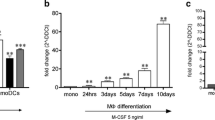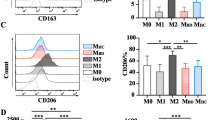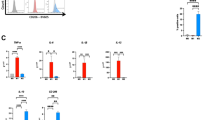Abstract
Acidic mammalian chitinase (AMCase) and chitotriosidase (CHIT-1) are two active chitinases expressed in humans. The chitinase activity of AMCase was found to be causative in allergic inflammation and its expression was found to be induced by interleukin-13. CHIT1-1 is expressed by phagocytic cells and extremely high levels are seen in lysosomal storage diseases. Despite that AMCase expression in the inflammation is under investigation, little is known regarding its regulation during macrophages' full maturation and polarization. In this study, we compared AMCase and CHIT-1 modulation during monocyte to macrophage transition and polarization. Gene expression analysis was investigated by real-time PCR from mRNA of human monocytes obtained from buffy coat of healthy volunteers, from mRNA of polarized to classically activated macrophages (or M1), obtained by interferon (IFN)-γ and lipopolysaccharide (LPS) treatment, and from mRNA of alternatively activated macrophages (or M2) obtained by interleukin (IL)-4 exposure. Our results showed that the expression of AMCase and CHIT-1 were differently modulated in HMMs at different stage of maturation. The behavior of these two active chitinase suggests that in the immune response their role is complementary.





Similar content being viewed by others
References
Merzendorfer H, Zimoch L (2003) Chitin metabolism in insects: structure, function and regulation of chitin synthases and chitinases. J Exp Biol 206:4393e412
Bussink AP, Speijer D, Aerts JM, Boot RG (2007) Evolution of mammalian chitinase (-like) members of family 18 glycosyl hydrolases. Genetics 177:959–970
Funkhouser JD, Aronson NN Jr (2007) Chitinase family GH18: evolutionary insights from the genomic history of a diverse protein family. BMC Evol Biol 7:96
Boot RG, Blommaart EF, Swart E, Ghauharali-van der Vlugt K, Bijl N, Moe C, Place A, Aerts JM (2001) Identification of a novel acidic mammalian chitinase distinct from chitotriosidase. J Biol Chem 276:6770e8
Chou YT, Yao S, Czerwinski R, Fleming M, Krykbaev R, Xuan D, Zhou H, Brooks J, Fitz L, Strand J, Presman E, Lin L, Aulabaugh A, Huang X (2006) Kinetic characterization of recombinant human acidic mammalian chitinase. Biochemistry 45:4444–4454
Zhu Z, Zheng T, Homer RJ, Kim YK, Chen NY, Cohn L, Hamid Q, Elias JA (2004) Acidic mammalian chitinase in asthmatic Th2 inflammation and IL-13 pathway activation. Science 304:1678e82
Bierbaum S, Nickel R, Koch A, Lau S, Deichmann KA, Wahn U, Superti-Furga A, Heinzmann A (2005) Polymorphisms and haplotypes of acid mammalian chitinase are associated with bronchial asthma. Am J Respir Crit Care Med 172:1505–1509
Reese TA, Liang HE, Tager AM, Luster AD, van Rooijen N, Voehringer D, Locksley RM (2007) Chitin induces accumulation in tissue of innate immune cells associated with allergy. Nature 447:92–96
Malaguarnera L (2006) Chitotriosidase: the yin and yang. Cell Mol Life Sci 63:3018–3029
Labadaridis I, Dimitriou E, Theodorakis M, Kafalidis G, Velegraki A, Michelakakis H (2005) Chitotriosidase in neonates with fungal and bacterial infections. Arch Dis Child Fetal Neonatal Ed 90:F531–F532
Boot RG, Renkema GH, Strijland A, van Zonneveld AJ, Aerts JM (1995) Cloning of a cDNA encoding chitotriosidase, a human chitinase produced by macrophages. J Biol Chem 270:26252–26256
van Eijk M, Voorn-Brouwer T, Scheij SS, Verhoeven AJ, Boot RG, Aerts JM (2010) Curdlan-mediated regulation of human phagocyte-specific chitotriosidase. FEBS Lett 584:3165–3169
Boven LA, van Meurs M, Boot RG, Mehta A, Boon L, Aerts JM, Laman JD (2004) Gaucher cells demonstrate a distinct macrophage phenotype and resemble alternatively activated macrophages. Am J Clin Pathol 122:359–369
Brinkman J, Wijburg FA, Hollak CE, Groener JE, Verhoek M, Scheij S, Aten J, Boot RG, Aerts JM (2005) Plasma chitotriosidase and CCL18: early biochemical surrogate markers in type B Niemann-Pick disease. J Inherit Metab Dis 28:13–20
Barone R, Bertrand G, Simporè J, Malaguarnera M, Musumeci S (2001) Plasma chitotriosidase activity in beta-thalassemia major: a comparative study between Sicilian and Sardinian patients. Clin Chim Acta 306:91–96
Bargagli E, Maggiorelli C, Rottoli P (2008) Human chitotriosidase: a potential new marker of sarcoidosis severity. Respiration 76:234–238
Comabella M, Domínguez C, Rio J, Martín-Gallán P, Vilche A, Vilarrasa N, Espejo C, Montalban X (2009) Plasma chitotriosidase activity in multiple sclerosis. Clin Immunol 131:216–222
Artieda M, Cenarro A, Gañán A, Lukic A, Moreno E, Puzo J, Pocoví M, Civeira F (2007) Serum chitotriosidase activity, a marker of activated macrophages, predicts new cardiovascular events independently of C-reactive protein. Cardiology 108:297–306
Malaguarnera L, Simporè J, Prodi DA, Angius A, Sassu A, Persico I, Barone R, Musumeci S (2003) 24-bp duplication in exon 10 of human chitotriosidase gene from the sub-Saharan to the Mediterranean area: role of parasitic diseases and environmental conditions. Genes Immun 4:570–574
Palasik W, Fiszer U, Lechowicz W, Czartoryska B, Krzesiewicz M, Lugowska A (2005) Assessment of relations between clinical outcome of ischemic stroke and activity of inflammatory processes in the acute phase based on examination of selected parameters. Eur Neurol 5:188–193
Di Rosa M, Dell’Ombra N, Zambito AM, Malaguarnera M, Nicoletti F, Malaguarnera L (2006) Chitotriosidase and inflammatory mediator levels in Alzheimer’s disease and cerebrovascular dementia. Eur J Neurosci 23:2648–2656
Malaguarnera L, Di Rosa M, Zambito AM, Dell’Ombra N, Di Marco R, Malaguarnera M (2006) Potential role of chitotriosidase gene in nonalcoholic fatty liver disease evolution. Am J Gastroenterol 101:2060–2069
Malaguarnera L, Di Rosa M, Zambito AM, Dell’Ombra N, Nicoletti F, Malaguarnera M (2006) Chitotriosidase gene expression in Kupffer cells from patients with non-alcoholic fatty liver disease. Gut 55:1313–1320
Ross R, Ross XL, Ghadially H, Lahr T, Schwing J, Knop J, Reske-Kunz AB (1999) Mouse langerhans cells differentially express an activated T cell attracting CC chemokine. J Invest Dermatol 113:991–998
Martinez FO, Sica A, Mantovani A, Locati M (2008) Macrophage activation and polarization. Front Biosci 13:453–461
Di Rosa M, Zambito AM, Marsullo AR, Li Volti G, Malaguarnera L (2009) Prolactin induces chitotriosidase expression in human macrophages through PTK, PI3-K, and MAPK pathways. J Cell Biochem 107:881–889
Cakır G, Gumus S, Ucar E, Kaya H, Tozkoparan E, Akgul EO, Karaman B, Deniz O, Kurt I, Ozkan M, Bilgic H (2012) Serum chitotriosidase activity in pulmonary tuberculosis: response to treatment and correlations with clinical parameters. Ann Lab Med 32:184–189
Bargagli E, Margollicci M, Nikiforakis N, Luddi A, Perrone A, Grosso S, Rottoli P (2007) Chitotriosidase activity in the serum of patients with sarcoidosis and pulmonary tuberculosis. Respiration 74:548–552
Iyer A, van Eijk M, Silva E, Hatta M, Faber W, Aerts JM, Das PK (2009) Increased chitotriosidase activity in serum of leprosy patients: association with bacillary leprosy. Clin Immunol 131:501–509
Malaguarnera L, Ohazuruike LN, Tsianaka C, Antic T, Di Rosa M, Malaguarnera M (2010) Human chitotriosidase polymorphism is associated with human longevity in Mediterranean nonagenarians and centenarians. J Hum Genet 55:8–12
Di Rosa M, Mangano K, De Gregorio C, Nicoletti F, Malaguarnera L (2012) Association of Chitotriosidase Genotype with the development of nonalcoholic fatty liver disease. Hepat Res. doi:10.1111/j.1872-034X.2012.01063.x
Mosser DM, Edwards JP (2008) Exploring the full spectrum of macrophage activation. Nat Rev Imm 8:958–969
Zimmermann N, Mishra A, King NE, Fulkerson PC, Doepker MP, Nikolaidis NM, Kindinger LE, Moulton EA, Aronow BJ (2004) Rothenberg Transcript signatures in experimental asthma: identification of STAT6-dependent and -independent pathways. J Immunol 172:1815–1824
Martinez FO, Helming L, Gordon S (2009) Alternative activation of macrophages: an immunologic functional perspective. Annu Rev Immunol 27:451–483
Pourcet B, Feig JE, Vengrenyuk Y, Hobbs A, Kepka-Lenhart D, Garabedian M, Morris SM Jr, Fisher EA, Pineda-Torra I (2011) LXR{alpha} regulates macrophage arginase 1 through PU.1 and interferon regulatory factor 8. Circ Res 109:492–501
Da Silva CA, Hartl D, Liu W, Lee CG, Elias JA (2008) TLR-2 and IL-17A in chitin-induced macrophage activation and acute inflammation. J Immunol 181:4279–4286
Acknowledgments
Giulia Malaguarnera is supported by the International Ph.D. Program in Neuropharmacology (Coordinator Prof. Filippo Drago), University of Catania Medical School, Catania, Italy.
Author information
Authors and Affiliations
Corresponding author
Electronic supplementary material
Below is the link to the electronic supplementary material.
Rights and permissions
About this article
Cite this article
Di Rosa, M., De Gregorio, C., Malaguarnera, G. et al. Evaluation of AMCase and CHIT-1 expression in monocyte macrophages lineage. Mol Cell Biochem 374, 73–80 (2013). https://doi.org/10.1007/s11010-012-1506-5
Received:
Accepted:
Published:
Issue Date:
DOI: https://doi.org/10.1007/s11010-012-1506-5




